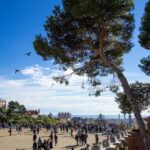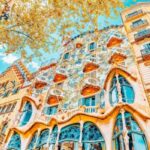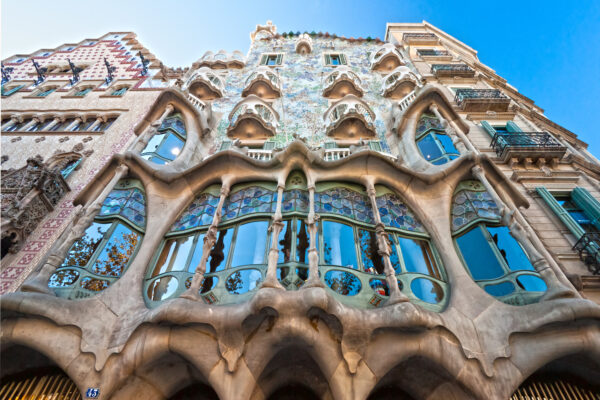
- The Genius of Gaudí: Exploring His Iconic Masterpiece in Barcelona
- Architectural Marvel: The Unique Features of Gaudí's Masterpiece
- Cultural Significance: Why Gaudí's Work is a Testament to Barcelona's Identity
- Visiting Gaudí's Masterpiece: A Complete Guide for Tourists
- The Influence of Nature in Gaudí's Artistry: A Deep Dive into His Techniques
- Historical Context: Understanding the Era of Gaudí’s Iconic Creation
Barcelona is a city renowned for its extraordinary architecture and vibrant culture, with Antoni Gaudí standing out as one of its most celebrated figures. His unique vision and innovative techniques have left an indelible mark on the city's skyline, captivating visitors from around the world.
Among his many creations, An Iconic Masterpiece by Gaudí in Barcelona is the Sagrada Família, a basilica that seamlessly blends Gothic and Art Nouveau styles. This monumental work not only represents Gaudí's genius but also symbolizes the heart and soul of Barcelona, making it a must-visit destination for art and architecture enthusiasts.
The Genius of Gaudí: Exploring His Iconic Masterpiece in Barcelona
Gaudí's artistic vision is deeply rooted in his love for nature, which is evident in the organic shapes and forms found throughout his works. The Sagrada Família is particularly notable for its intricate facades that represent various elements of nature, incorporating motifs such as trees, stones, and even animals. This harmony between architecture and the natural world showcases Gaudí's belief that nature is the ultimate architect, influencing both the aesthetics and structural integrity of his designs.
One of the most striking features of the Sagrada Família is its towering spires, which symbolize the connection between earth and divinity. Each spire is dedicated to a different religious figure, creating a profound spiritual experience for visitors. These spires are part of a larger architectural language that Gaudí developed, characterized by hyperbolic parabolas and intricate geometrical shapes that challenge traditional building techniques.
As you explore the interior of the basilica, you'll encounter a breathtaking fusion of light and color, thanks to the stained glass windows that cast vivid hues onto the stone surfaces. This play of light transforms the space, creating a serene atmosphere that invites contemplation. The use of natural light was a crucial aspect of Gaudí's design philosophy, demonstrating his intent to bring the divine into the everyday experience of the viewer.
In summary, the Sagrada Família is not just a testament to Gaudí's ingenuity but also a reflection of his deep spiritual beliefs and connection to the world around him. Visitors are often left in awe of the masterpiece's complex symbolism and artistic brilliance, making it an essential stop for anyone seeking to understand the genius of Gaudí. Its ongoing construction, driven by a commitment to Gaudí's original vision, underscores the enduring legacy of this iconic masterpiece in Barcelona.
Architectural Marvel: The Unique Features of Gaudí's Masterpiece
Antoni Gaudí's architectural marvels are characterized by their unconventional forms and intricate details. The Sagrada Família, in particular, showcases a remarkable blend of natural inspiration and innovative engineering. Its façade features a variety of sculptures depicting biblical stories, reflecting Gaudí's deep commitment to his faith and the narrative intent behind the basilica’s design.
One of the unique features of this masterpiece is the use of catenary arches, which allow for greater structural stability and fluidity in the design. These arches not only support the weight of the building but also create a visually stunning effect that enhances the overall aesthetic. Additionally, Gaudí's incorporation of colorful ceramics and mosaics adds a vibrant touch, making each section of the Sagrada Família a feast for the eyes.
Gaudí's innovative approach extends to the interior, where the towering columns resemble tree trunks, branching out to support the ceiling in a way that mimics a forest canopy. This design not only creates a sense of wonder but also improves acoustics, allowing the space to carry sound beautifully. As visitors walk through this sacred space, they experience a profound connection to nature and spirituality.
In conclusion, the Sagrada Família is a testament to Gaudí's visionary genius and his ability to harmonize architecture with the natural world. The combination of unique structural elements, intricate artistry, and spiritual symbolism makes this basilica a true architectural marvel. Its ongoing construction is a reminder of Gaudí's timeless legacy and the enduring beauty that continues to captivate all who visit.
Cultural Significance: Why Gaudí's Work is a Testament to Barcelona's Identity
The cultural significance of Antoni Gaudí's work in Barcelona extends far beyond its aesthetic appeal. His masterpieces, particularly the Sagrada Família, have become emblematic of the city's identity and spirit. Gaudí's architecture reflects the unique cultural synthesis of Catalonia, harmonizing traditional influences with innovative techniques that challenge the norms of design.
Gaudí’s work serves as a testament to Barcelona’s history and values, encapsulating the spirit of a city that embraces creativity and originality. His buildings are not mere structures; they are vibrant narratives that invite interpretation and connection. Key elements that highlight this cultural significance include:
- Innovative Design: Gaudí's unique approach to form and space fosters a dialogue between architecture and nature.
- Spiritual Symbolism: The Sagrada Família, dedicated to the virtues of the Christian faith, reflects the importance of spirituality in Barcelona's cultural landscape.
- Catalan Identity: His works celebrate the distinctiveness of Catalan culture, contributing to a sense of pride among locals.
Furthermore, Gaudí’s influence permeates various aspects of Barcelona's urban fabric, inspiring contemporary architects and artists alike. The city’s commitment to preserving and completing his vision ensures that future generations will continue to experience the profound connection between Gaudí's creations and the identity of Barcelona. This ongoing dialogue not only enhances the cultural richness of the city but also reinforces its place as a global hub for art and architecture.
In essence, Gaudí's masterpieces are reflections of the vibrant, evolving story of Barcelona. By blending artistic innovation with deep cultural roots, his work remains a living testament to the city's identity, inviting both locals and tourists to engage with the unique narrative of this iconic metropolis.
Visiting Gaudí's Masterpiece: A Complete Guide for Tourists
When visiting Gaudí's masterpiece, the Sagrada Família, it’s essential to plan ahead to fully appreciate its grandeur. Start by purchasing your tickets online to avoid long queues, especially during peak tourist seasons. Consider opting for a guided tour to gain deeper insights into the architectural and spiritual significance of this iconic basilica. The audio guides also provide an enriching experience, allowing visitors to explore at their own pace.
Don't miss the opportunity to explore the basilica's striking façades. Each side tells a different story, showcasing Gaudí’s intricate attention to detail. Be sure to capture photos of the Nativity Façade, adorned with scenes from Christ's birth, and the Passion Façade, which reflects the dramatic narrative of his crucifixion. As you walk around, take a moment to appreciate the interplay of light and shadow created by the unique architectural design.
For a complete experience, consider visiting during the golden hours of sunrise or sunset. The light streaming through the stained glass creates a breathtaking atmosphere that enhances the spiritual ambiance of the interior. Additionally, you can explore the adjoining museum to learn more about Gaudí's life, his artistic process, and the ongoing construction of the Sagrada Família, which remains a work in progress.
Lastly, to enrich your visit, take a stroll through the nearby Park Güell, another of Gaudí's masterpieces. This vibrant park features colorful mosaics and organic forms that echo his architectural style, providing a perfect complement to your exploration of the Sagrada Família. By experiencing both sites, you'll gain a comprehensive understanding of Gaudí's impact on Barcelona and its architectural heritage.
The Influence of Nature in Gaudí's Artistry: A Deep Dive into His Techniques
The influence of nature in Antoni Gaudí's artistry is evident in his meticulous attention to organic forms and structures, which he often drew from the natural world. Gaudí believed that nature was the ultimate guide in design, leading him to incorporate elements such as curvilinear shapes and natural textures in his work. This harmonious relationship between architecture and nature is most vividly illustrated in the Sagrada Família, where each façade evokes different aspects of the natural environment, making the building feel alive and dynamic.
Gaudí's techniques often involved the use of biomimicry, where he studied natural forms and patterns to inspire his architectural solutions. For instance, the tree-like columns within the Sagrada Família support the structure while simultaneously mimicking the form of a forest canopy, creating a sense of tranquility and wonder. This approach not only enhances the aesthetic experience but also serves to promote sustainability, as it reflects the interconnectedness of all living things.
In addition to forms and structures, Gaudí's use of color and light was deeply influenced by nature. The stained glass windows of the Sagrada Família are designed to capture the changing qualities of light throughout the day, casting vibrant colors within the interior that shift from warm hues at sunrise to cool tones at sunset. This deliberate manipulation of light not only beautifies the space but also symbolizes the divine, reflecting Gaudí's belief that nature is a manifestation of God's creation.
Moreover, Gaudí's approach to design was heavily influenced by his studies of geological formations and the behavior of natural elements. He often utilized geometric principles inspired by nature, such as the hyperbolic parabola, to create structures that are both visually striking and structurally sound. This innovative blend of mathematical precision and organic inspiration set Gaudí apart as a pioneering figure in architecture, allowing his work to resonate with the rhythms of the natural world.
Historical Context: Understanding the Era of Gaudí’s Iconic Creation
The era in which Antoni Gaudí flourished was marked by a vibrant cultural and artistic renaissance in Spain, particularly in Catalonia. This period, known as the Modernisme movement, emerged in the late 19th and early 20th centuries, characterized by a departure from traditional styles and a celebration of new artistic expressions. Gaudí's work became synonymous with this movement, intertwining architecture, art, and craftsmanship in ways that were revolutionary for his time.
During Gaudí's lifetime, Barcelona was undergoing significant transformations, driven by industrial growth and urban expansion. The city was embracing modernization while simultaneously seeking to preserve its unique Catalan identity. This context played a crucial role in Gaudí's designs, as he infused local traditions and natural forms into his works. Key elements of this historical context include:
- Industrialization: The rapid urbanization led to new architectural challenges and opportunities.
- Nationalism: A growing sense of Catalan pride fueled the desire for distinct cultural expressions.
- Artistic Innovation: The Modernisme movement encouraged experimentation with new materials and forms.
In addition to these social and cultural shifts, Gaudí was heavily influenced by the spiritual and religious climate of his time. His deep Catholic faith informed much of his work, particularly the Sagrada Família, which was envisioned as a testament to his beliefs. The basilica's intricate details and symbolic elements reflect the religious fervor prevalent in the late 19th century, making it a profound expression of faith and artistry. This intertwining of spirituality and architecture set Gaudí apart, allowing his creations to resonate on both an aesthetic and a spiritual level.
The world around Gaudí was also witnessing a surge of artistic movements across Europe, from Impressionism to Symbolism. These movements encouraged a focus on emotion, symbolism, and the exploration of new perspectives. Gaudí embraced these ideas, incorporating them into his designs to create spaces that evoke wonder and contemplation. His innovative use of color, light, and organic shapes reflects a broader artistic trend of seeking to connect art with the human experience, making his works timeless masterpieces that continue to inspire generations.
 Sagrada Familia in Barcelona to be completed by 2026
Sagrada Familia in Barcelona to be completed by 2026 Acquista i biglietti per la Casa Batlló online o in loco
Acquista i biglietti per la Casa Batlló online o in loco Bilety na Casa Batlló - gdzie kupić?
Bilety na Casa Batlló - gdzie kupić?If you want to know other articles similar to An Iconic Masterpiece by Gaudí in Barcelona you can visit the category WHERE YOU CAN GO.
Deja una respuesta










Read more!